Mental Health App Development: How to Build an App Backed by Science
A recent study identified 1,435 mental health apps. The number of people looking to improve self-care and manage any mental health issues with the help of mobile apps is growing all over the world. Despite the abundance of solutions, most lack scientific credibility.
In this post, we highlight the most important aspects of mental health app development, look at the best-performing programs, and define what makes mental health solutions helpful.
What Constitutes an App for Mental Wellbeing?
The very premise of a mental health application is to improve people’s overall wellbeing. This goal can be obtained in numerous ways: some solutions provide support to patients with illnesses and disorders, others motivate people to learn how to manage stress and improve their mood, and some connect people with therapists remotely.
Apps that help mental health can be divided by the type of problem they solve or by the methodology they use. They are designed for a variety of reasons: preventing depression, managing anxiety, treating workplace burnout, eliminating negative thinking, improving sleep, meditation, to help develop healthy habits, and more.
In addition, there are mental health test apps that aim to help users identify any problems, apps designed to complement treatment plans, and apps that help users relax and boost positive thinking.
Some apps try to combine several of these branches (for example, by tracking sleep cycles and boosting moods) but the majority of mental health apps are very specific. Apart from depression and anxiety, two of the major issues people turn to apps for help with, applications can be focused on other illnesses for instance, PTSD coaching or eating disorder management.
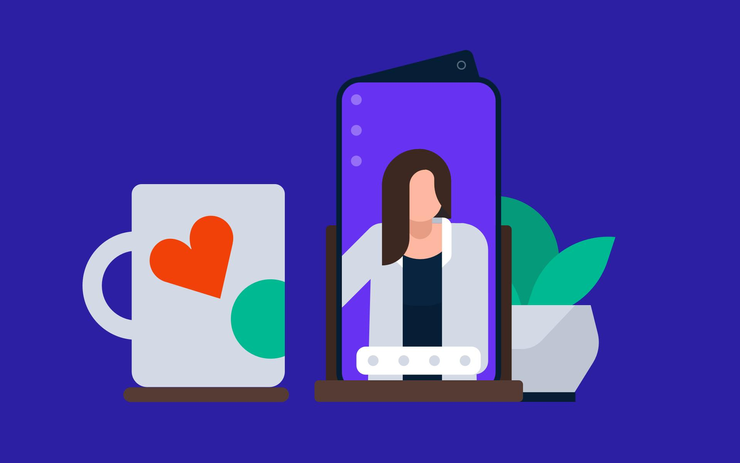
What Can Your App Focus On?
In mental health app development, it’s always best to have a clear focus. You need to choose the exact type of mental health app you want to create and learn what your solution needs to deliver on its promises.
This 2019 study evaluated 73 market leaders among the available mental health mobile apps for Android and iOS. Researchers found the majority (59) were dedicated to a single functionality. Only a few apps described two or three discrete functions or didn’t describe any.
The most common types of mental health apps are as follows:
Symptom Monitoring
For many conditions, such as anxiety, depression, and post-traumatic stress disorder, it’s enough to pass a simple test involving questions about mood, sleep, and current thoughts. Thus, it’s easy to incorporate such a test into a mobile app.
However, only those solutions facilitated by clinical psychologists and other mental health professionals can be used and trusted. More importantly, these self-assessment apps should only be an initial tool before consultation or treatment with an expert. Apps alone can’t help people deal with their mental health problems but they may help users understand the situation better.
WhatsMyM3 is a mental health tracker app that checks for symptoms of depression, bipolar disorder, PTSD, and anxiety. The test takes only three minutes and is designed to motivate people to understand their condition and take action if needed. The crucial thing about this app is that it’s strongly validated by academic researchers and clinicians.
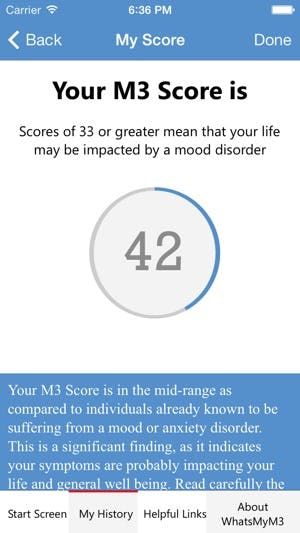
WhatsMyM3. Source: App Store
Mood Journaling
Many apps in the mental health domain are mood journals which ask users to rate how they feel each day or once a week and then make graphs out of the data. Mood trackers are linked to symptom detection but unlike the latter, they require constant activity on a day-to-day basis.
John M. Grohol, Psy.D., distinguishes several reasons why self-monitoring tools are helpful:
- They can identify the triggers affecting mood changes
- For those in treatment, they can visualise mood variations over a given time period
- Used over time, they can detect whether a prescribed medication has a positive impact
Existing mood trackers are similar to each other in that all offer day-to-day journals with charts and statistics. What distinguishes such programs are the additional components: some monitor local weather, sleep, and pill intake (eMoods), others track activities (Daylio), and still others include hashtags for identifying mood triggers (Moodtrack Diary).
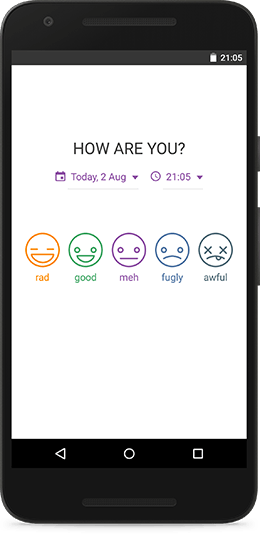
Daylio. Source: daylio.webflow.io
Mood apps also differ in the rating systems they use: iMood Journal has a one-to-ten scale with one being “couldn’t be worse” and ten being “really great;” Daylio offers five emojis indicating mood from “awful” to “rad;” eMoods suggests rating states such as anxiety on scale from “none” to “severe.”
The thing that matters most is credibility. The apps we’ve mentioned present their services in different ways. Those lacking recommendations from professionals who were involved in the app’s development lack credibility. If you’re up to making a new solution in this field, put a heavy focus on thorough clinical research to provide proven insights.
Psychoeducation
Apart from giving users an opportunity to assess and analyse mood and important triggers, mental health apps can provide information on a variety of topics from specific illnesses to general wellbeing. This review of mental health chatbots highlighted the benefits psychoeducation programs offer.
Online Therapy
Mental health support apps can act as intermediaries connecting people to certified therapists. Talkspace and BetterHelp are the most popular programs for online therapy with a wide range of psychologists for users to select and book appointments.
Millions of people are attracted to these services and for good reason; sessions are more affordable and flexible than offline options. Talkspace currently has more than a million registered users and BetterHelp has over 4 million customers in the US alone.
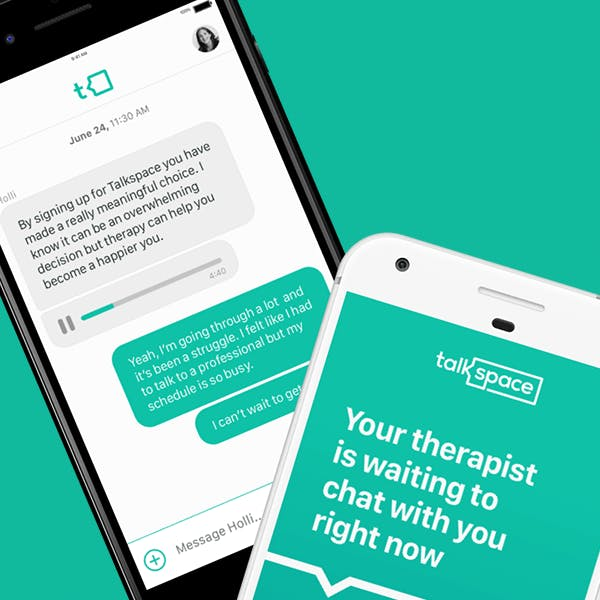
Talkspace. Source: talkspace.com
Another therapeutic tool mobile apps use is chatbots. The question of whether AI will replace human therapists rises to the surface on occasion and stirs up disputes in the media. The universal answer to that question is “no” AI-powered chatbots cannot replace traditional therapy but they can be an effective additional component to traditional treatment.
Wysa and Woebot are the most acclaimed mental health apps utilising chatbot technology. In both, the AI-powered companion asks questions and creates recommendations based on the answers. These apps share a cognitive behavioural therapy approach and Wysa also uses techniques from dialectical behaviour therapy. Besides the chat feature, Weabot provides evidence-based lessons and exercises.
Released in 2016, Wysa claims 400,000 users and the completion of over 80 million conversations via the app. Woebot, created a year later, now receives nearly 2 million conversations a week. Such popularity shows the need for chatbot solutions, and both apps cope with the task quite well. Key here is that both have a solid team behind the service and have kept the apps user-friendly and positive in design.
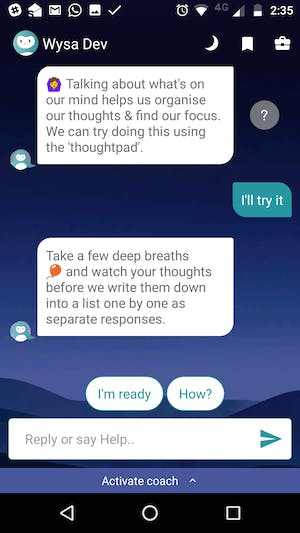
Wysa. Source: wysa.io
As Dr. Dillon Browne notices in this app review, the problem with chatbots is the lack of personalisation and an ignorance of “nuanced concerns.” Most psychologists suggest limiting the use of such programs to the purpose of keeping patients involved in their therapy outside sessions and under no consideration using them as a full-value alternative for treatment.
Community Support
Since there are many benefits to group therapy, some mental health applications create a peer-support community. For instance, Sanvello (formerly Pacifica) has a mood tracker, guided journeys, and a community which allows people to share and discuss their stories.
Another example is the TalkLife app, which is devoted solely to a community where users share their experiences and find encouragement. It is proven that peer support results in an increased ability to cope with mental health issues and a higher level of overall confidence.
Meditation
Relaxation and overcoming negative thoughts are among the common purposes of mental health apps. With the rise of the mindfulness trend and people becoming more aware of meditation techniques, apps for getting calmer and more relaxed, as well as for learning to identify inner states and building paths to “the better version of myself,” gained massive success.
We touched upon this issue in our post about health app developers, describing the two top meditation apps, Headspace and Calm. If you’re interested in this domain, you’ll need to come up with a completely unique idea to beat such strong competitors.
Clearly, mobile apps for mental wellbeing can make therapeutic techniques more accessible and flexible. They can also remove any barriers to treatment for many people. However, the science behind them still isn’t there to provide an adequate alternative to traditional therapy. Let’s see what other challenges may cause trouble to app developers.

How Effective are Mental Health Solutions?
Most applications people download quickly become of no use, and health-related apps are no exception. The challenge is not only to engage people but, more importantly, provide them with actual help.
As the authors of this Australian app market report note, most mental health mobile apps are developed by commercial entities. The sector is under-regulated which makes it possible for anyone to create a mental health solution with little or no positive evidence. There are thousands of mental health apps for iPhone and Android, while a minuscule proportion (slightly over 50) are approved by authorities such as the NHS, NICE, or the Federal Drug Agency.
This evaluation study of mental health app stores shows that many companies don’t support their products with a solid evidence base or health professional input. The authors detected that most apps with positive evidence are linked to cognitive behavioural therapy in relation to depression and anxiety or dialectical behaviour therapy for self-harm.
The authors suggest that app stores provide a new standard which requires developers to report which mental health practitioners they have onboard, which published articles are related to the app, and how the service is compliant with real-life practice. The need for a proper evaluation framework is also described in this comparative study.
It’s crucial for consumers to know who is responsible for the app’s content and how to contact them. Applications without information about the team, their experience, and the techniques they use on a dedicated website clearly lose out to those who do offer this information.

How Mental Health Phone Apps Establish Credibility
We examined the websites of several mental health applications. Here is how some of them establish credibility:
- Fabulous claims to be “science-based” and statements noting the product was envisioned in the Behavioral Economics Lab of Duke University.
- Happify also claims “evidence-based solutions” and, more importantly, gives information about the experts who created the app and features articles on the science of happiness.
- Happier You names the therapists who wrote their courses for mindfulness and coping with depression.
- Self-Help for Anxiety Management (SAM) states the University of the West of England was involved in development.
- Joyable gives short bios of advisors with expertise in the treatment of anxiety and depression.
- My Possible Self indicates content from the Black Dog Institute and uses established forms of therapy including the cognitive behavioural approach.
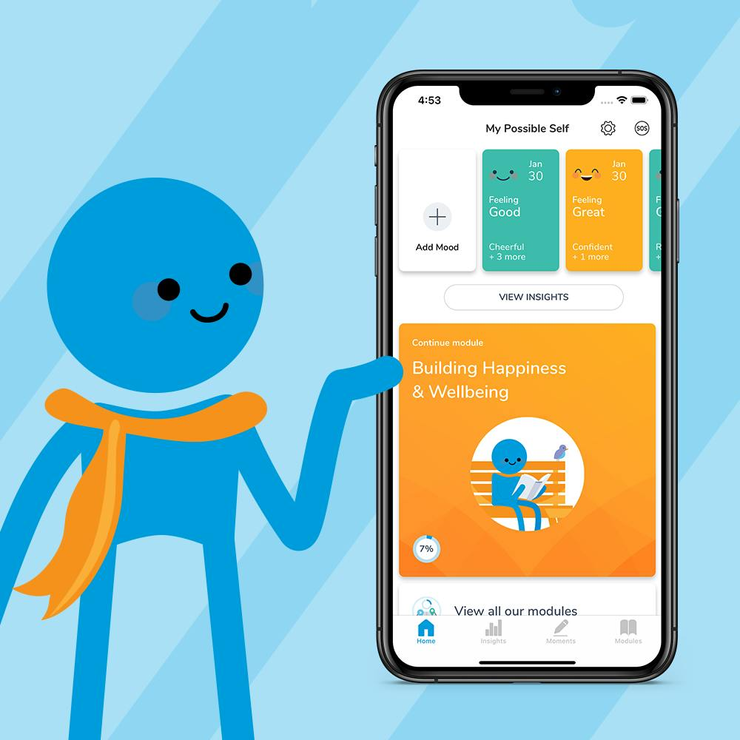
My Possible Self. Source: the app's Facebook page.
Some applications had no information about the mental health practitioners or university research teams working on their development including Present (guided meditation sessions), Reflectly (an AI companion which asks users about their day), and Maslo (an AI app which asks users to talk for a minute and then analyses captured words).
Health Information Security
Since patient information is very sensitive, mental health apps should abide by national privacy laws. For Australia, check the Privacy Principles of the Privacy Act. If the app is classified as a medical device, it requires a more complicated process of certification. This report, which we mentioned earlier, gives detailed instructions on what to do in such cases.
AI Is Not Always the Answer
The idea of AI transforming self-care has been exploited to a great extent in both the media and in app development. There are so many AI solutions that it’s hard to keep track of them all.
One great initiative, called PsyberGuide, engages experts to review mental health apps but the percentage of apps included in the guide is too low. To support the statement that scientific credibility should come first, check out this hilarious analysis of Reflectly where the author argues that despite its cute design, this AI-based tool fails to engage people to reflect on their mood and life goals.
To sum it up, your mental health app should be evidence-based. Provide an adequate privacy policy and full information on the developers and experts so users feel confident about your product. To keep your service fun and engaging, mix it up with game-like elements, which you can learn about from our post on app gamification.
21 November 2019
